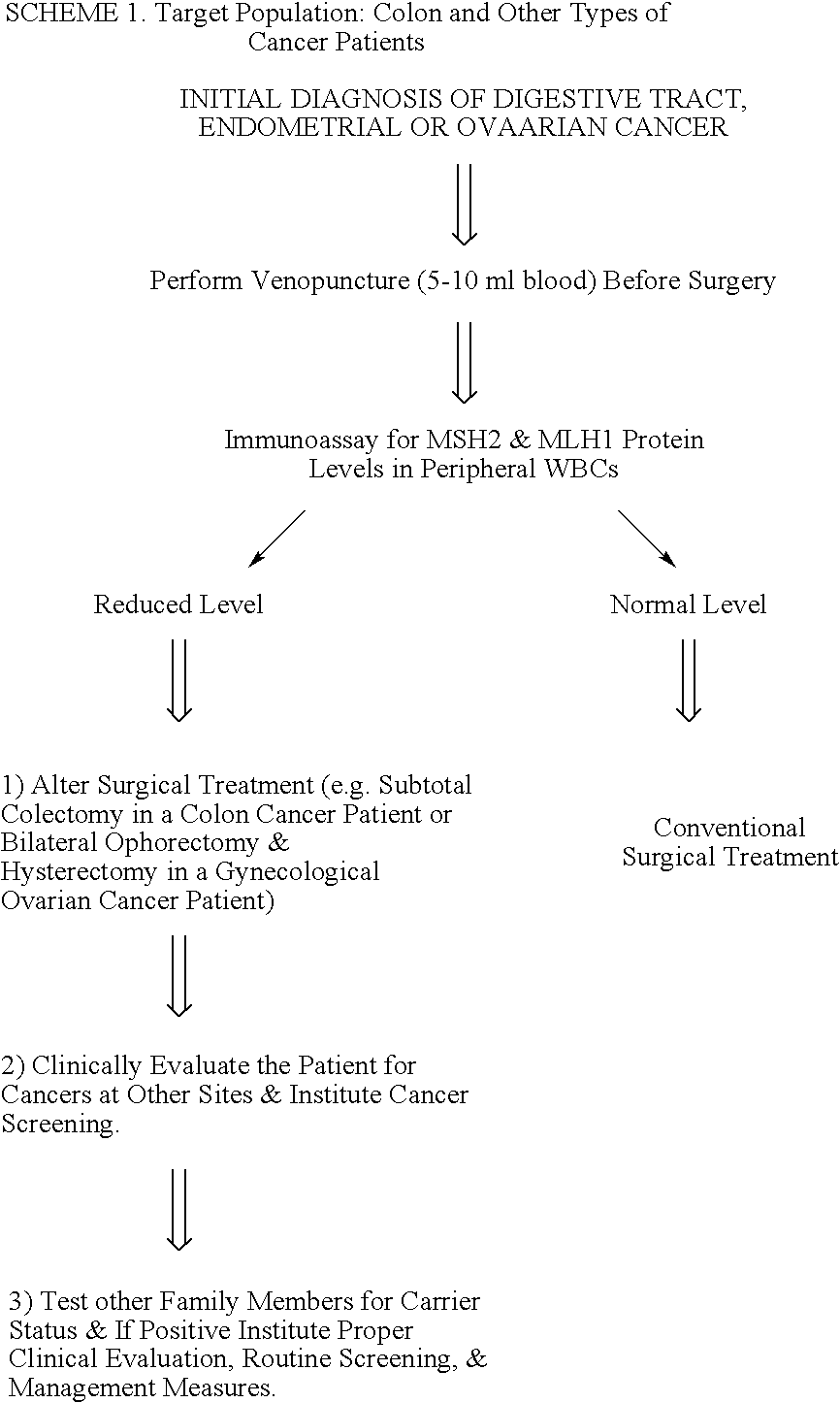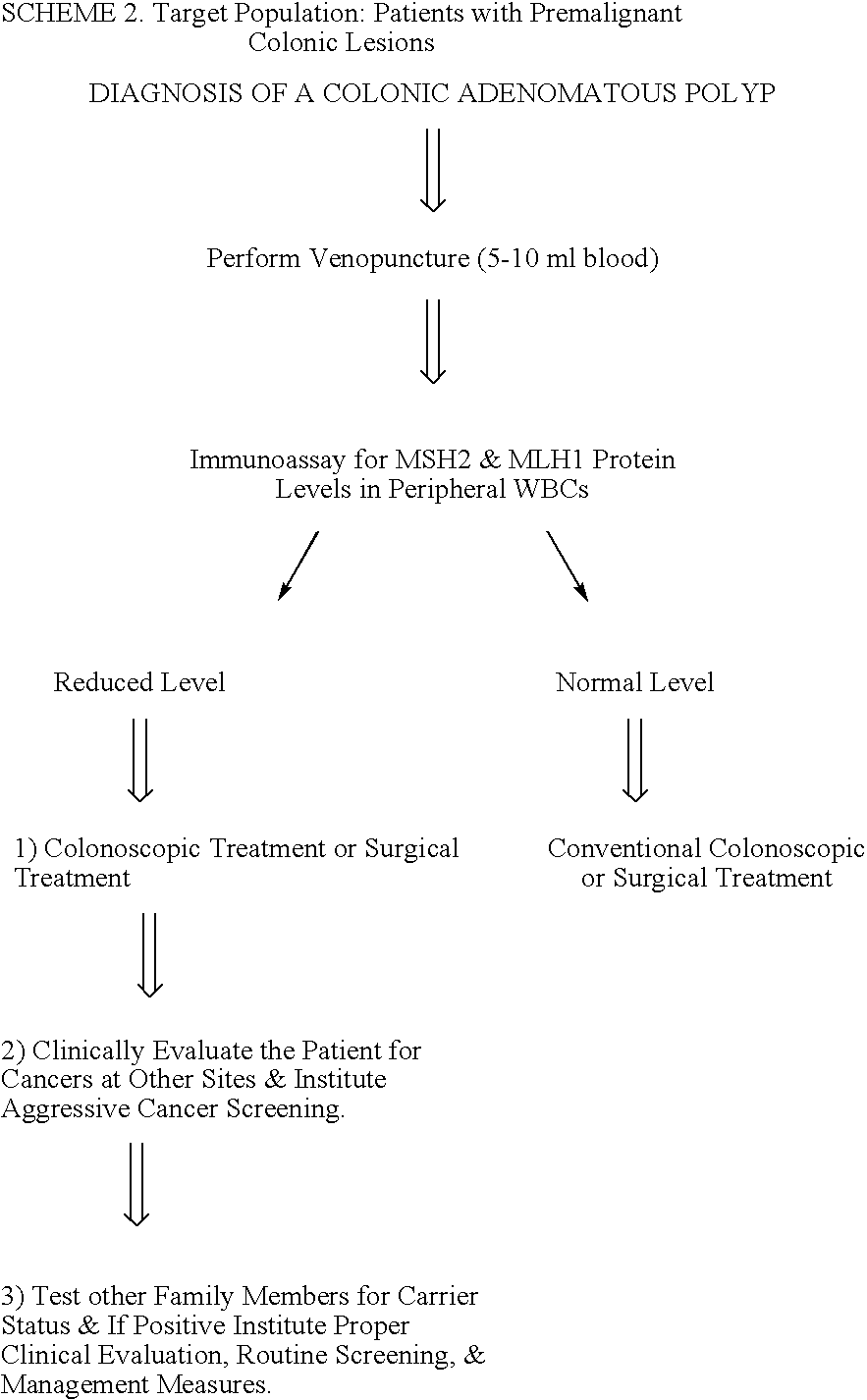Immunoassays to detect diseases or disease susceptibility traits
a technology of immunoassays and diseases, applied in the field of medical genetics, can solve the problems of large amount of work and cost involved in performing current molecular based assays to identify hereditary traits associated with diseases, and differences in the surgical treatment of cancer,
- Summary
- Abstract
- Description
- Claims
- Application Information
AI Technical Summary
Problems solved by technology
Method used
Image
Examples
example 1
[0203] (a) Immunoprecipitation of Full-length APC Gene Product
[0204] Anti-APC antibodies were used in this study to immunoprecipate full-length APC from the lymphocytes of FAP patients, who are known to have one mutant and one remaining wild-type APC allele in their germline. This study supports the theory underlying the immunoassays of this invention in that the lymphoblastoid cells from the FAP patients were shown to have about 50% less (50.10%±5.1%) immunoprecipitatable full-length APC protein in comparison to controls lacking germline APC mutations. The results correlate with the heterozygous APC genotypic status in FAP cells.
[0205] Materials and Methods
[0206] Anti-APC Antibody. Anti-APC polyclonal rabbit antibody (APC-2), generated in the inventor's laboratory as described elsewhere [Boman et al., “Radioimmunoassay of the APC gene product using antibodies against its middle and carboxyl regions,”Biochem. Biophys. Res. Commun., 206: 909-915 (1995); Chop et al., “Immunodetecti...
example 2
[0220] Western Blot Immunoassay for MLH1 and MSH2 Proteins
[0221] This example describes the measurement of MLH1 and MSH2 proteins (the expression products of 2 major MMR genes) in freshly prepared lymphocytes and in immortalized lymphocytes. The assay, which includes Western blot analysis, evaluates the expression levels of both full-length proteins simultaneously in a single lymphocyte sample. Semi-quantitative analysis of levels of MLH1 and MSH2 by Western blot allows easy and direct determination of full-length MLH1 / full-length MSH2 protein ratios for the same sample.
[0222] Due to the variability in sample loading and to other confounding factors, the approach used determines the individual expression level of each of the two proteins, and then the ratio of one to the other is calculated. Then it is determined whether the numerical value of the ratio falls clearly in the normal range, or clearly in the range predicted if there were 50% loss of expression of one of the two prote...
example 3
Detection of Full-Length MMR Proteins in Intact Lymphocytes by Flow Cytometry
[0232] This example shows that full-length MMR proteins can be detected successfully in intact lymphocytes by flow cytometry. Full-length MMR protein levels in cells can be accurately measured by flow cytometry. It is predicted that flow cytometry will produce fully quantitative data.
[0233] Preliminary data show that flow cytometry can be used to detect the MSH-2 protein. A lymphoblastoid line was used to establish conditions for detection of intracellular MSH-2 protein using two different anti-MSH-2 antibodies. Cells were fixed and permeabilized (using a Fix & Perm™ cell permeabilization kit; Caltag Burlingame, Calif.). Cells were incubated with one of two primary antibodies. One is anti-MSH-2 ABI (Oncogene Research Products)—that has been pre-labeled with a fluorescent probe (phycoerythrin [PE]). This antibody is specific to the amino terminus of MSH-2. The other antibody is anti-MSH-2 AB2 (Oncogene Res...
PUM
| Property | Measurement | Unit |
|---|---|---|
| size | aaaaa | aaaaa |
| size | aaaaa | aaaaa |
| concentration | aaaaa | aaaaa |
Abstract
Description
Claims
Application Information
 Login to View More
Login to View More - R&D
- Intellectual Property
- Life Sciences
- Materials
- Tech Scout
- Unparalleled Data Quality
- Higher Quality Content
- 60% Fewer Hallucinations
Browse by: Latest US Patents, China's latest patents, Technical Efficacy Thesaurus, Application Domain, Technology Topic, Popular Technical Reports.
© 2025 PatSnap. All rights reserved.Legal|Privacy policy|Modern Slavery Act Transparency Statement|Sitemap|About US| Contact US: help@patsnap.com


